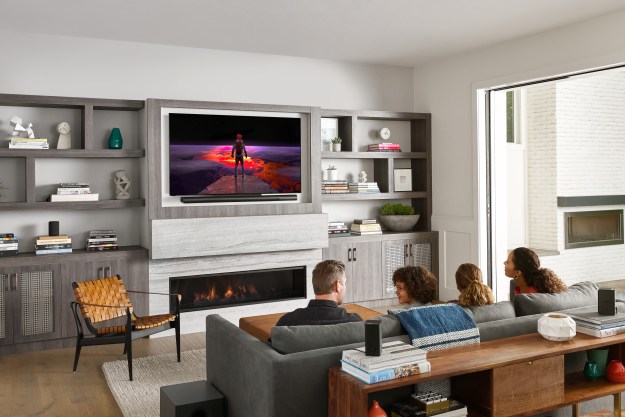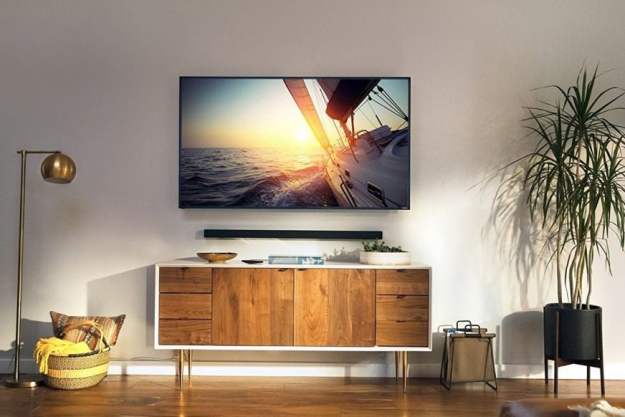
“While falling short of the Sonos One, the Harman Kardon Invoke is a solid smart speaker debut for Cortana.”
- Beautifully designed, with sleek lines and a premium finish.
- Clear, impactful 360-degree audio with strong mid-range and punchy bass.
- Hands-free Skype calls to mobiles and landlines.
- Cortana assistant integration across PC, mobile and speaker.
- Small but well executed selection of smart home controls and third-party integrations.
- Sounds lacks the warmth and presence of Sonos One
- No multi-room audio support
- Limited range of music services and other third-party integrations
Ready for the smart speaker explosion? It’s taken a little time for specialist audio manufacturers to follow the lead of Amazon Echo and Google Home, but momentum is building with speakers flooding the market at a range of price points that pack Alexa, Siri, or the Google Assistant. What Bluetooth speakers were to 2015, smart speakers are to 2017 and beyond – and we’re just getting started.
We recently reviewed (and loved) the Sonos One, the company’s reinvention of their Play:1 speaker, combining superb sound quality and excellent Alexa integration (with
Now there’s a smart speaker with a new (old) sheriff in town: Cortana. While Cortana has been around on the Microsoft platform for awhile, we haven’t heard her in a smart speaker. That’s no longer the case, thanks to Harman Kardon’s new Invoke Cortana-enabled speaker, available starting Sunday. Find out how well the speaker measured up to other smart speakers on the market in our Harman Kardon Invoke review.
While Cortana has been around for awhile, we haven’t heard her in a smart speaker.
While you can expect many more “me too” speakers to launch over the coming months, the Harman Kardon Invoke stands out for a few reasons. The $199 device is the first speaker to launch with Microsoft’s Cortana digital assistant (and possibly the only device, although HP and Intel have signed up to develop reference hardware, which may stimulate others to follow).
The partnership combines Harman Kardon’s premium audio expertise with Microsoft’s online services – notably Cortana and Skype – as well as Windows 10 PC connectivity, the Bing knowledge graph, Office 365 calendars and newly-announced smart home device integration. A range of third-party Cortana skills extend features, but you won’t have the breadth of support you’d get from Amazon
With Harman Kardon (recently acquired by Samsung) also announcing the Alexa-enabled Allure speaker, the Invoke may represent somewhat of an experiment for all parties. The question is whether the Invoke delivers the combination of quality and intelligence that can compete against the tsunami of smart speakers flooding the market. If it doesn’t, given Microsoft’s reputation for canning hardware and services that don’t make the grade, the Invoke may end up as a collector’s item.
Refined hardware design with a beautiful finish
We were impressed by the design of the Harman Kardon Invoke, when announced back in May, with its sleek lines, gentle curves and chrome finish building on Amazon Echo’s cylindrical form.
Available in a choice of pearl silver or graphite, the Invoke has all the visual design cues you’d expect from a premium audio stable.
In hand, the impact is even more impressive. From the carbon-black packaging with spot-varnished branding, to the punched metal speaker surround and slow, weighty action of the volume ring, the Harmon Kardon Invoke bleeds quality. Even the branded (and somewhat large) power supply has folding pins, making it more convenient for travel.
While there are clear visual similarities with both Amazon Echo and
Impressive audio engine packed into a svelte chassis
Despite its sleek 4.2 by 9.5 inch-dimensions, the Invoke packs a mighty 360-degree audio engine under the hood. Two vertical passive radiators fitted to the top half of the device are joined by a lower cluster of three direct-radiating 0.5-inch tweeters. Below them, a further three direct-radiating 1.75-inch woofers drive the low-end. Total power output is rated at 40 W, with a frequency response of 60-20kHz (-6dB).
That’s one more microphone than the
At the top of the device, seven far-field microphones (that’s one more than the
It’s an impressive array, especially when you consider the single tweeter and mid-woofer equipped in the
Wide range of controllers, including Voice, App and PC
The Invoke supports manual control courtesy of a volume ring and capacitive touch panel at the top of the device. A short tap (less than three seconds) stops or responds to whatever is happening on the speaker, for example, stopping playback, answering an incoming call or cancelling a timer. If the speaker is idle, a quick tap provides a “fun fact” from Cortana – a small distraction if you’re bored, or hours of fun for the kids.

A long tap is used to activate Cortana (alongside the usual, “Hey Cortana” voice command) or to ignore a call. We found the manual controls to be intuitive and responsive; however, it’s more likely that you’ll use a combination of voice and the
Simple setup via your smartphone
Power on the device and a cloudy, swirling pattern emanates from the touch panel. It’s much subtler than Echo’s bright blue LED ring or Google Home’s circle of indicators. Located on top of a reasonably tall device, it’s also less visible. We found ourselves having to stand up and head over to the speaker to check the display, which was quite inconvenient. However, displaying Cortana’s blue and white ring adds a little personality to the design.
Setup is performed using your
Before you get going, however, you’ll be invited to connect your preferred music services and calendars. At this time,
Clear, punchy sound that beats Amazon and Google, but comes up short against Sonos.
We tested the Hardman Kardon Invoke alongside a
Invoke’s audio is balanced and refined.
Invoke’s audio is balanced and refined. It can play loud, for sure, getting a little ragged at the top of the speaker’s range, but music certainly doesn’t distort as much as with Amazon Echo at high volume. There’s more than enough volume to fill a large space and the 360-degree driver positioning means that’s it’s the perfect speaker to place at the center of the room.
Compared to the cheaper
Streaming over Bluetooth worked well, with pairing guided by Cortana when we pressed the relevant button on the rear of the device. Invoke offers the best streaming experience with Spotify, with Spotify Connect app controls working out of the box for playback. Open up the Spotify app on your phone, hit Devices Available and off you go.
Given the difference in speaker configuration to the Play:1, we were expecting the Invoke to top even the excellent sound quality of Sonos’ entry-level speaker. Certainly, the Invoke’s 360-degree sound is an advantage over the Play:1, but we actually preferred the warmer tone and greater presence of the
That doesn’t make the Invoke a bad speaker, and it certainly beats both Amazon Echo and
Hands-free Skype calls, calendars, alarms and smart home control
While Cortana has been around for more than three years, it’s been quickly overtaken by Amazon and Google’s aggressive push to dominate and control the smart home. While Cortana may be available on 500 million Windows 10 PCs in 13 countries, the hearts and minds of consumers – and the support of hardware manufactures – is most firmly with competitors.
The launch of Invoke is designed to tackle that challenge, in part, but there’s a long way to go. Perhaps the jewel in the crown, at launch, is Skype integration. Invoke supports Skype-to-Skype as well as calls to landlines and mobiles through the speaker. We found that hands-free calling over Skype worked well, with Cortana able to connect to Skype callers by name and landlines or mobiles via a dictated number. Better still, Cortana can find and call numbers with relatively vague commands. Say, “Cortana, call the nearest Italian restaurant” and hey, that’s what she’ll do!
Calls to US phone numbers are free (for the first six months only, which is disappointing), while you can also call abroad using Skype credits. While Invoke is able to receive incoming Skype calls, there’s sadly no support for hands-free calling via your phone’s Bluetooth connection.
Invoke can access Office 365 and Outlook.com calendars alongside handy features like timers, alarms and lists, plus location and time-based reminders. One advantage of using Cortana is that events can be created on your PC, on your phone or the speaker and you’ll receive notifications across your devices.
There’s also integrated support for smart home devices, with Wink, SmartThings and Insteon hubs available at launch, plus direct connections to Nest and Philips Hue. We found Cortana did a good job of handling basic tasks like powering our Philips Hue Lights and even controlling brightness, but color changes were out of the question. Controlling our Nest Learning Thermostat was also mostly successful, but Cortana did complain that she was unable to change the temperature on a couple of occasions.
Perhaps the jewel in the crown, at launch, is Skype integration.
Throughout our time with the Harman Karman Invoke, the speaker’s integrated far-field microphones did a good job of picking up commands from around the room, even with music playing.
Of course, with Amazon
While it fails to hit the highs of the
Our Take
The Harmon Kardon Invoke isn’t the best smart speaker available today, but it’s a strong debut for Microsoft’s Cortana in a good-looking, great-sounding device. Skype, Outlook and Office 365 integration will attract Microsoft fans and smart home device control works well, but Invoke doesn’t have quite the quality or flexibility to beat
Is there a better alternative?
At $199, the
There’s also the Siri-enabled Apple HomePod ($350), the range-topping/wallet-draining Google Home Max ($400) and enhanced Amazon Echo Plus ($150).
How long will it last?
In recent times, Microsoft has developed a poor reputation for sustaining consumer products and services that don’t turn into instant blockbusters. For every Xbox and Surface, there’s a Zune, Groove or Microsoft Band. With limited support from other hardware manufacturers and significant competition ahead, Invoke may well be the first and last Cortana-enabled smart speaker.
Should you buy it?
If you’re a Microsoft fan and you’re all in on Cortana, you’re going to love the Harman Kardon Invoke. Everyone else, check out the competition, or just pick up the
Editors' Recommendations
- Sonos Voice Control hands-off review: Now we’re talking
- 20-year-old design lives on in Harmon Kardon’s $300 Aura Studio 3 speaker












